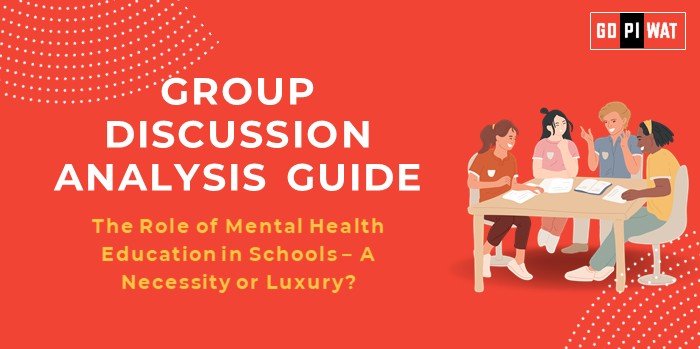📋 Group Discussion Analysis Guide: The Role of Mental Health Education in Schools – A Necessity or Luxury?
🌐 Introduction to the Topic
- 📍 Opening Context: Mental health is as vital as physical health, yet often neglected, especially in educational institutions. Globally, rising mental health issues among students highlight the urgency of addressing this critical aspect.
- 📊 Topic Background: The WHO states that half of all mental illnesses begin by the age of 14, yet most cases remain untreated due to stigma and lack of awareness. Mental health education in schools could act as a preventive measure, fostering resilience and reducing long-term societal costs.
📊 Quick Facts and Key Statistics
- 🌍 WHO Estimate: 10-20% of children and adolescents globally experience mental health conditions.
- 🇮🇳 National Data (India): 15% of adolescents face mental health issues, yet 85% lack access to support.
- 📘 Global Comparison: Countries like Australia and Finland incorporate mandatory mental health curricula, reporting a 30% drop in adolescent depression rates.
- 💰 Economic Impact: Poor mental health in young people costs economies billions annually in lost productivity.
🤝 Stakeholders and Their Roles
- 🏛️ Government: Policy formulation, funding for mental health programs, and integration into educational policies.
- 🏫 Schools and Teachers: Implementing mental health curricula, early identification, and creating safe spaces.
- 👨👩👧👦 Parents and Communities: Reducing stigma and providing a supportive environment for children.
- 👩⚕️ Healthcare Professionals: Designing age-appropriate interventions and offering counseling services.
🏆 Achievements and Challenges
🌟 Achievements
- 📢 Increased Awareness: Mental health awareness campaigns have led to reduced stigma in many regions.
- 📜 Policy Initiatives: The National Education Policy 2020 in India emphasizes holistic student well-being.
- 🧩 Successful Models: Australia’s “KidsMatter” program integrates mental health into schools, yielding positive outcomes.
⚠️ Challenges
- 🚧 Stigma: Mental health is still taboo in many cultures, preventing open discussions.
- 💸 Resource Constraints: Schools often lack trained counselors or adequate funding for mental health programs.
- 📉 Implementation Gaps: Policies exist but are poorly executed in many regions.
🌍 Global Comparisons
- 🇫🇮 Finland: Comprehensive well-being programs include mental health as a core educational subject.
- 🇺🇸 United States: States like New York mandate mental health education, significantly reducing stigma.
📖 Case Study
🌟 Kerala, India: Introduced the “Souhrida Club” initiative to support student mental health, covering over 50,000 students annually.
💬 Structured Arguments for Discussion
✅ Supporting Stance
“Mental health education is a necessity, as untreated issues during adolescence lead to lifelong challenges.”
❌ Opposing Stance
“Mental health education is a luxury for underfunded schools struggling with basic literacy goals.”
⚖️ Balanced Perspective
“While essential, mental health education must be balanced with adequate infrastructure and teacher training to be effective.”
🚀 Effective Discussion Approaches
🔑 Opening Approaches
- 📊 Start with a Statistic: “15% of adolescents in India face mental health issues, yet only a fraction receive help.”
- 🌍 Highlight Global Best Practices: “Finland’s school-based mental health programs demonstrate the potential of early intervention.”
🤝 Counter-Argument Handling
“While costs are a concern, evidence from successful international programs shows long-term savings in healthcare and productivity.”
🔍 Strategic Analysis of Strengths and Weaknesses
📊 SWOT Analysis
- 💪 Strengths: Rising awareness, policy support, and success in pilot programs.
- ⚠️ Weaknesses: Stigma, funding issues, and lack of trained professionals.
- ✨ Opportunities: International collaborations, leveraging technology for remote support.
- 🚧 Threats: Resistance from conservative sections of society, competing priorities in education budgets.
🎓 Connecting with B-School Applications
- 🌍 Real-World Applications: Students can explore topics like public-private partnerships in mental health education or study the economic implications of mental health neglect.
- 💬 Sample Interview Questions:
- 💡 “How can schools balance academics with mental health initiatives?”
- 💡 “What role can technology play in making mental health education scalable?”
- 🚀 Insights for B-School Students: Developing mental health policies for schools can be an impactful consulting project. Innovations in mental health technology present entrepreneurial opportunities.


